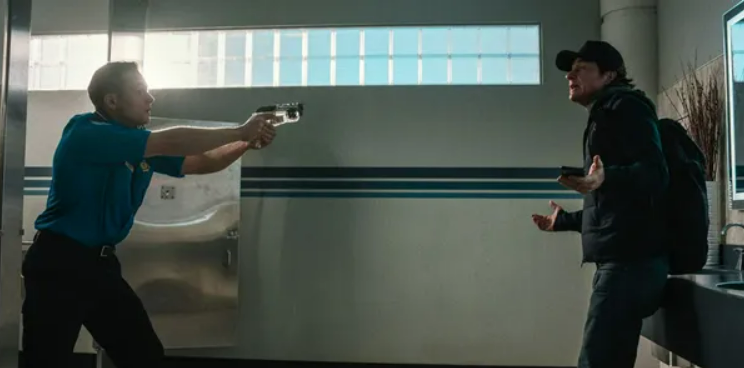Netflix’s Carry-On (2024) is the most recent Hollywood action film I have viewed. An intriguing Christmas film about an airport TSA agent, Ethan Kopek, played by Taron Egerton, who finds himself in an impossible situation, when a traveler goes through his security lane and forces him to choose between allowing a bomb to make it onto a flight, or not allowing the bomb onto the flight, but instead putting the entirety of the airport in danger instead on Christmas day, the busiest day of the year. Ethan is unable to alert his superiors or ask for help, because the mastermind behind the situation who is unnamed, played by Jason Bateman, has eyes on Ethan’s girlfriend Nora, played by Sofia Carson. He warns him that the moment Ethan even thinks about saying anything, he will have his hitman take out Nora, no hesitation. Oh, and did I mention she is also pregnant.
The screengrab I have provided is the perfect example of how this film structures its action sequences. The scene takes place in the airport bathroom, starting off with Ethan placing a “No Entry” sign, so he can throw up from all the stress, this is when the traveler, Batemans character, finally reveals himself, and his gun. They have a conversation where Ethan attempts to talk him out of the decision, but fails, and starts throwing up again. We move on to another scene, and shortly after, we return to the bathroom, this time with anger. During this scene from 01:05:02 – 01:06:33, the camera is handheld, and shaky. Ethan is washing his face in the sink, and we have a frame in frame shot of him in the mirror. Immediately after, Batemans character walks in and throws him against the wall. The camera quickly pans from right to left following this action. Then it cuts up to a closeup of Batemans face as he punches Ethan, then cuts to Ethan in a medium/wide shot taking the punch. The camera pans from right to left again, as Bateman throws Ethan into the stall door, and we have an extreme closeup of Ethan’s face taking the hit. It then cuts to a dutch angle of Bateman punching Ethan’s gut. In the angle, we can see Ethan’s face, but the traveler’s face is hidden. This humanizes Ethan, and dehumanizes the traveler. The camera closes up on Ethan’s face again, showing him in extreme pain again, seemingly unable to take his hits, and we can still see glimpses of Batemans face, but never from a full close up, or front view, keeping a mysterious aura around his character. We then cut to a wide shot of Ethan falling on the ground landing on his hands and knees, the camera tilts form up to down, almost falling with Ethan. Then we have an intense dutch angle on the traveler kicking Ethan while he’s already down. Then the camera cuts to a wide two shot, of Ethan getting kicked in this small bathroom space, with nowhere for him to run. Next clip is a closeup of Ethan’s face squished against the bathroom floor. Almost every shot of the traveler is a dutch angle, or a medium shot with his face to the side. The next few seconds are back and forth shots of Bateman talking down on Ethan as the camera follows along with him, and cutting back to Ethan slowly gaining strength and getting up from the floor. All this is still on a shaky, handheld camera. Then a wide shot of the traveler standing tall over Ethan on the ground. Ethan finally gets up and punches the traveler in the face, and he flies into the wall. This is presented as a dutch angle. Then Bateman overtakes Ethan and has him in a chokehold, this is in a profile, close up. The camera tilts down, as Bateman slides down the wall, taking Ethan with him. We then have a wide, front view shot of this. We then get an extreme closeup of the gun in the traveler’s jacket pocket, indicating that it will be used. We see an extreme closeup of Ethan being choked out, and this happens in a slight dutch angle. Ethan is able to grab the gun and he holds it against Batemans head. Suddenly Bateman releases Ethan, and he quickly gets up from the ground, still pointing the gun at him, and Bateman stays down. The power dynamic shifts. The camera is still shaky, and the next few shots are all wide shots. Ethan shoots the gun at the trash can to show Bateman that he is not messing around. The camera pans from left to right, following the bullet, then back from right to left with a wide shot of Bateman on the ground, with an over the shoulder angle of Ethan’s shoulder. We finally get a close up, front view of the traveler’s face, making him less powerful. He slowly gets up, obeying Ethan’s orders. It is a wide shot of the traveler, with the gun and Ethan’s arm visible on the left side of the screen. We now have a stand off between Ethan and the Traveler, shown between back and forth cuts of the two of them. The traveler pulls out his phone to call off the hitman as instructed by Ethan. We see a close up of the phone of the traveler instead arming the bomb, and starting its timer. He then reveals this to Ethan in a medium shot, with the focus being on the phone. We then see a close up of Ethan’s face in absolute terror. We then have a wide, profile, two shot, of Ethan holding the gun up in fear, and the traveler appearing unfazed, and calm, leaning against the bathroom sink. Ethan then lunges forward and holds the gun to his neck. The camera pans from left to right. The next few shots are close ups of the two faces. And the traveler talks him out of shooting him. The scene ends with Ethan running out of the bathroom, springing into action to disengage the timer.
As Carry-On is a Netflix original, it didn’t have a box-office gross, but was extremely successful with 97.1 million views within the first 10 days of its release and being Netflix’s #2 most popular movie. Some ways this film has created real life consequences is through a fear of air travel on the viewers, making viewers question how they would act in moral dilemmas, as well as desensitization to real-life threats, meaning, Hollywood films creating plots out of threats that could very much happen in real life, may desensitize viewers if ever faced into a similar situation.
References:
Mascelli, Joseph V. The five C’s of cinematography. Vol. 1. Hollywood: Grafic Publications, 1965.
https://d1wqtxts1xzle7.cloudfront.net/31165489/cv2009_11sredwine-libre.pdf?1392282135=&response-content-disposition=inline%3B+filename%3DThe_five_Cs_of_cinematography.pdf&Expires=1743232681&Signature=U4RNydcJNnev2L-jK0fSMpRR9kbqMdyn39WGlH2OjGzHg0B8RaXUxCnIebtUy2HVLs5U-tnW5YWbUx-tr~ReCQYqiUoCvAtc7AQVWGxToQr3SUOu~I5BN5NrRmtF7P0BcHUNPzNmv0NOPRwjilNXgNbaoxsTORScGfnXd~cee6iyR6Zszg8FpeNKAob8aN6Aq7e6ug5BFjAeHo~fE~tpiRheqHPTyxy3v43RQ2xb24tgCNPLLvXZ4MGzouQW5Gck-85PxMvSXmQwwGMMrH7t1Wyciy5VkELR56426B1Wqcz6gd4R7fNfh0wh4G5QmEuI4b5aR3al1SaSJyBqghwOlw__&Key-Pair-Id=APKAJLOHF5GGSLRBV4ZA
Hoser, Tania. Introduction to Cinematography: Learning through practice. Routledge, 2018.
https://doi.org/10.4324/9781315305318
Westlund, Jacqueline Kory, Sidney K. D’Mello, and Andrew K. Olney. “Motion Tracker: Camera-Based Monitoring of Bodily Movements Using Motion Silhouettes.” Plos One, 2015. https://doi.org/10.1371/journal.pone.0138636 .
Danieau, Fabien, Julien Fleureau, Philippe Guillotel, Nicolas Mollet, Marc Christie, and Anatole Lécuyer. “Toward Haptic Cinematography: Enhancing Movie Experiences with Camera-Based Haptic Effects.” IEEE MultiMedia 21, no. 2 (April 2014): 11–21. https://doi.org/10.1109/mmul.2013.64.
Leung, Tin Cheuk, and Shi Qi. “Globalization and the Rise of Action Movies in Hollywood.” Journal of Cultural Economics 47, no. 1 (January 14, 2022): 31–69. https://doi.org/10.1007/s10824-021-09438-z.
Mrug, Sylvie, Anjana Madan, Edwin W. Cook, and Rex A. Wright. “Emotional and Physiological Desensitization to Real-Life and Movie Violence.” Journal of Youth and Adolescence 44, no. 5 (October 19, 2014): 1092–1108. https://doi.org/10.1007/s10964-014-0202-z.
“Top 10 Most Popular Movies on Netflix of All Time.” Netflix Tudum. Accessed March 28, 2025. https://www.netflix.com/tudum/top10/most-popular.


Reese
I really appreciate the depth of this student’s analysis; it’s impressively strong and well thought-out. They demonstrate a clear understanding of the scene’s technical construction, particularly how the handheld camera work and the use of Dutch angles effectively build tension and create a sense of instability throughout the piece. I find it compelling how they highlight the way the constant shifts in perspective not only humanize Ethan but also keep the traveler’s character shrouded in mystery and a hint of menace. Their observations about the editing and shot choices resonate beautifully with the image they provided, showcasing their keen eye for detail.
However, while their breakdown of the scene is commendable, I feel they missed an opportunity to expand their discussion into the scholarly research they mentioned. They reference real-world consequences like desensitization and a fear of air travel, which are thought-provoking points, yet they don’t connect these ideas back to any specific academic studies or media research. It reads more like a collection of personal observations rather than a well-supported argument grounded in scholarly work.
That said, the analysis is rich with detail and passion, reflecting a high level of media literacy. If they had woven in one or two scholarly sources related to media violence or moral decision-making, I believe it would have strengthened their argument immensely. Overall, it’s really solid work, just a little more academic depth would take it to the next level!